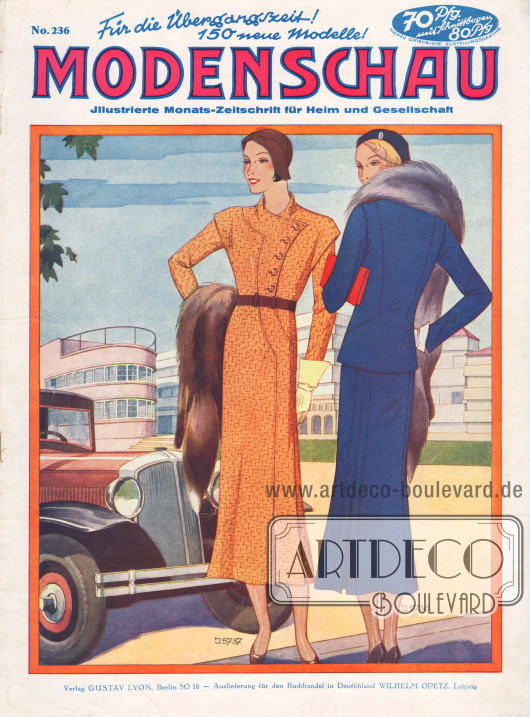|
|
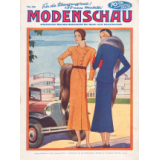
|
Front page or cover of the German fashion magazine Modenschau (subtitle: Illustrierte Monats-Zeitschrift für Heim und Gesellschaft) no. 236 of August 1932.
"For the transition period! 150 new models!".
5737: Snappy coat dress in jersey tweed. The distinctive cut effects dissolve into folds on the skirt.
5738: Youthful costume made of blue-colored wool fabric with an effectively split, slightly waisted jacket.
Cover art/title illustration: unknown/unsigned.
Publishing company Gustav Lyon, Berlin SO 16 - Delivery for the book trade in Germany Wilhelm Opetz, Leipzig.
|
|
|
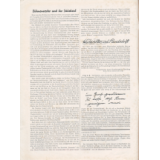
|
Article:
O. V., stage works and their fate;
Publisher Gustav Lyon, Department of Graphology, Character and Handwriting;
o. V., Anecdotes.
|
|
P. 1 |
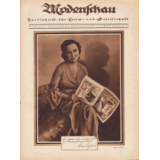
|
Front page or cover of the fashion show (subtitle: Zeitschrift für Heim und Gesellschaft) No. 236 of August 1932.
The title photo shows the Austrian film actress Lucie Englisch (1902-1965) sitting on the back of a sofa with a smile. In her hand she holds the June issue of the fashion show. The caption puts the words in Lucie Englisch's mouth: "The fashion show is my ideal every time to choose clothes! Lucie Englisch".
Photo: Nicolaier.
|
|
P. 2 |

|
Article (narrative):
Jarcho, Gregor, The enterprising Eria. An Armenian tale (by Gregor Jarcho, 1894-1949).
The narrative is supplemented by a drawing. It shows a man and a woman in a farmhouse, standing close to a table.
Drawing/Illustration: Heinz Raebiger (1903-ca.1955).
|
|
P. 3 |
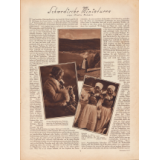
|
Article:
Erbach, Alwin, Swedish Miniatures (by Alwin Erbach, author and life data unknown).
The article shows three photographs from Sweden. The captions read "Warm landscape in central Sweden: On quiet summer evenings you can hear the shepherd's horn ringing far above the woods and the lake", "Old farmer's wife from Dalarna, one of the most idyllic areas of Sweden, in her winter costume" and "Gentle girls in their national costumes, which are still worn a lot in Sweden today".
Photos: Freytag.
|
|
P. 4 |
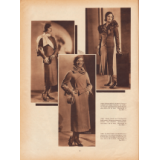
|
5865: Transition dress in green diagonal wool fabric with a smart tie in gaillac. Volume trim on the sleeves.
5866: Chic coat made of camel hair fabric, characterized by distinctive sloppy arrangements. In front cross piping.
5867: The snappy costume in reddish-brown Marengo has a jacket worked close to the body. The skirt has a bell-shaped front.
Photos: Joel Feder, New York City (biographical data unknown).
|
|
P. 5 |
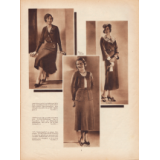
|
5868: Transition dress made of dark red wool crepe, finished with a bell-shaped skirt and a distinctive lap waist. Narrow wool fringe.
5869: Skirt and jacket in light brown wool jersey. The skirt has seam divisions. Jacket with yoke cut, button and loop trimming.
5870: Afternoon dress in green crepe mongol. Yellow and black patterned silk is used for the collar and sleeve garnish.
Photos: Joel Feder, New York City (biographical data unknown).
|
|
P. 6 |
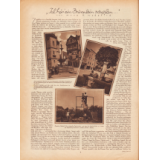
|
Article:
Wedekind, Anna P., I hear a fountain...
Matching the article are three photographs. The picture explanations are "A picturesque fountain in the small town of Weißenburg in Central Franconia is dedicated to the memory of the well-behaved field captain Schweppermann", "Right: The old market fountain in Tittmoning in Upper Bavaria, a town rich in medieval pictures, appears simple and clear" and "Primitive technique! An original pedal fountain used to irrigate the 'Radi' fields in Weichs near Regensburg".
Photos: Kester.
|
|
P. 7 |
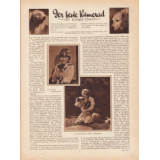
|
Article:
Greif, Ewald, The Best Companion (by Ewald Greif, author and life data unknown).
The article about dog and man presents four photographs. The picture explanations are "English sheepdog, his fur is white and shaggy, the eye bright and alert. This breed shows high intelligence. English Shetland, its head betrays the hunting dog, which does not give up hunting prematurely. Both photos are taken from the excellent work 'Mein Hundebuch' by Hedda Walther, published by Dietrich Reimer A. G., Berlin", "Two funny playfellows" and "her best friend".
Photos: Hedda Walther (1894-1979); Paramount.
|
|
P. 8 |
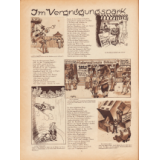
|
Article (rhyme):
Malkowsky, Emil Ferdinand, In the amusement park (by Emil Ferdinand Malkowsky, 1880-1965);
drawings/illustrations: Hans Kossatz (1901-1985).
|



